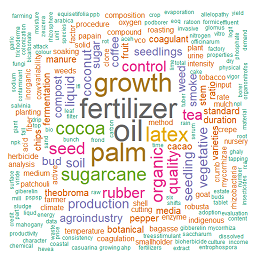Potensi Kandungan Minyak Kelapa Sawit dengan Berbagai Tingkat Berondolan Lepas di Piringan
DOI:
https://doi.org/10.25181/jaip.v9i2.2161Keywords:
harvesting, oil to bunch ratio, oil to wet mesocarp ratio, ripe fruitAbstract
Harvesting fresh fruit bunches (FFB) is an important activity in the oil palm plantation industry. This study aimed to analyze the potential content of palm oil at the level of loose fruit that falls on the oil palm circle. Observations were made on five fresh fruit bunches with criteria 1, 3, and 5 respectively loose fruit per bunch that falls on the oil palm circle from oil palm trees that were 22, 16, 12, and 7 years old. All sample fresh fruit bunches were analyzed for potential oil to bunch ratio and oil to wet mesocarp ratio in the analytical laboratory of Bumitama Gunajaya Agro. Content of oil to wet mesocarp ratio in loose fruit 1, 3, and 5 were 48.50%, 51.98%, and 53.21% respectively. While the content of oil to bunch ratio in loose fruit 1, 3, and 5 were 24.19%, 25.52%, and 25.71% respectively. Based on variable of oil to wet mesocarp ratio, the highest potential for oil content occurs in ripe palm fruit with a level of five loose fruit per bunch that falls on that oil palm circle. Five loose fruit per bunch on the oil palm circle can be used as an indicator for harvesters to harvest ripe fruit with optimal oil content.Downloads
References
Badan Pusat Statistik. (2019). Statistik Kelapa Sawit Indonesia. Badan Pusat Statistik. Jakarta. 137 pp.
Basyuni, M., Amri, N., Putri, L., Syahputra, I., & Arifiyanto, D. (2017). Characteristics of fresh fruit bunch yield and the physicochemical qualities of palm oil during storage in North Sumatra, Indonesia. Indones. J. Chem., 17(2), 182–190.
Corley, R.H.V., & Law, I.H. (2001). Ripening, harvesting and oil extraction. The Planter, 77(906), 507–524.
Corley, R.H.V., & Tinker, P.B. (2015). The Oil Palm, Fifth Edition. In The Oil Palm: Fifth Edition. https://doi.org/10.1002/9781118953297
Donough, C.R., Chew, K.W., & Law, I. (1996). Effect of fruitset on oer and ker: Results from studies at pamol estates (Sabah) sdn bhd. The Planter, 72, 203–219.
Garima, G., Rajni, B., & Mahipat, S.R. (2015). Oxidation of cooking oils due to repeated frying and human health. Int. J. Sci. Technol. Manag., 4(1), 495–501.
Harun, M.H., & Noor, M.R. (2002). Fruitset and oil palm components. J. Oil Palm Res., 14(2), 24–33.
Hasibuan, H.A., Rahmadi, H.Y., & Faizah, R. (2014). Teknik sampling yang representatif dan akurat dalam penentuan kadar minyak dan inti pada tandan buah sawit segar. Warta Pusat Pen. Kelapa Sawit Indones., 19(2), 49–55.
Hasibuan, H.A. (2020). Determination of yield, quality and chemical composition of palm oil and palm kernel oil of fresh fruit bunches with variation maturity as a basic for determining harvest maturity standard. Indones. J. Oil Palm Res., 28(3), 123–132.
Hazir, S., & Amiruddin, M.D. (2012). Determination of oil palm fresh fruit bunch ripeness – based on flavonoids and anthocyanin content. Ind. Crops & Prod., 36, 466–475.
Keshvadi, A., Endan. H., Harun, Ahmad, D., & Saleena, F. (2011). Palm oil quality monitoring in the ripening process of fresh fruit bunches. J. Adv. Engin. Sci. & Tech., 4(1), 26–52.
Lionny, C.D., Susanto, W.H., & Maligan, J.M. (2015). Palm post harvesting handling (The spraying of sodium benzoate and potassium sorbate to CPO quality. J. Food Agro., 3(2), 489–498.
Okoye, M.N., Okwuagwu, C.O., & Ugurui, M.I. (2009). Population improvement for fresh fruit bunch yield and yield components in oil palm (Elaeis guineensis Jacq). Am-Eurasian. J. Sci. Res., 4(2), 59–63.
Mathews, J., Lee, A., Clarence, P., Chung, M., & Rao, S. (2004). Oil content in oil palm fruit mesocarp and bunch, and some of its related physiological and agronomical factors. The Planter, 80(938), 273–294.
Melwita, E., Fatmawaty, & Oktaviani. (2014). Ekstraksi minyak biji kapuk dengan metode sokletasi. J. Tek. Kim., 1(20), 20–27.
Purba, I.R., Irsal, & Meiriani. (2017). Hubungan fraksi kematangan buah dan ketinggian tandan terhadap jumlah buah memberondol pada panen kelapa sawit (Elaeis guineensis Jacq) di kebun rambutan PTPN III. J. Agrotek., 5(2), 315–328.
Rangkuti, I. (2018). Rendemen dan komponen minyak sawit mentah berdasarkan tingkat kematangan buah pada elevasi tinggi. Agrotekma, 3(1), 10–16.
Rao, V., Gomez, V., Chayawat, N., Chia, C.C., & Lim, C.C. (2001). Some factors influencing oil/bunch, oer and ker. Proceedings of the 2001 PORIM International Palm Oil Congress (Agriculture), Kuala Lumpur. 167–191.
Razali, M., Somad, A., Halim, A., & Roslan, S. (2012). A review on crop plant production and ripeness forecasting. Int. J. Agric. Crop. Sci., 4(2), 54–63.
Sujadi, Hasibuan, H.A., Rivani, M., & Purba, A.R. (2016). Oil content and chemical composition in the parts of oil palm fruit from 8 IOPRI varieties. J. Pen. Kelapa Sawit, 24 (2), 67–76.
Downloads
Published
How to Cite
Issue
Section
License
Copyright (c) 2021 Fitrah Murgianto, Edyson Edyson, Adhy Ardiyanto, Shadiar Kesuma Putra, Lilik Prabowo

This work is licensed under a Creative Commons Attribution-ShareAlike 4.0 International License.
Authors who publish with Jurnal Agro Industri Perkebunan agree to the following terms:
Authors retain copyright and grant the Jurnal Agro Industri Perkebunan right of first publication with the work simultaneously licensed under a Creative Commons Attribution License (CC BY-SA 4.0) that allows others to share (copy and redistribute the material in any medium or format) and adapt (remix, transform, and build upon the material for any purpose, even commercially) with an acknowledgment of the work's authorship and initial publication in Jurnal Agro Industri Perkebunan.
Authors are able to enter into separate, additional contractual arrangements for the non-exclusive distribution of the journal's published version of the work (e.g., post it to an institutional repository or publish it in a book), with an acknowledgment of its initial publication in Jurnal Agro Industri Perkebunan. Authors are permitted and encouraged to post their work online (e.g., in institutional repositories or on their website) prior to and during the submission process, as it can lead to productive exchanges, as well as earlier and greater citation of published work.


























